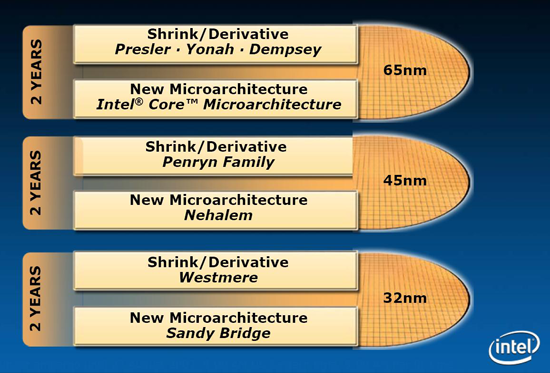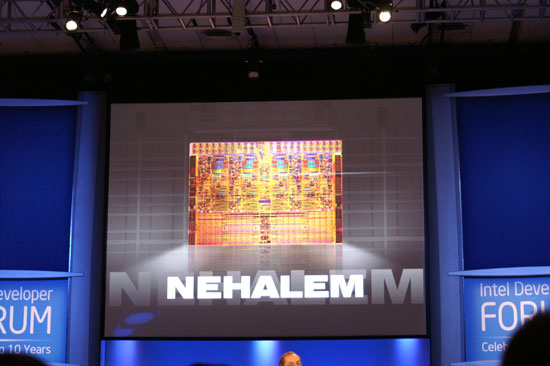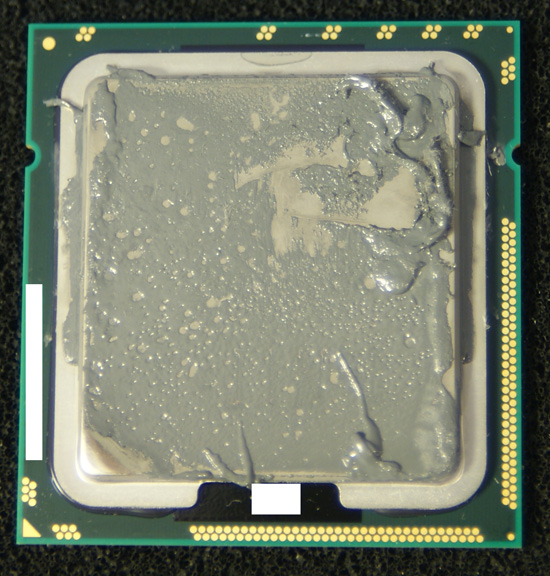The Nehalem Preview: Intel Does It Again
by Anand Lal Shimpi on June 5, 2008 12:05 AM EST- Posted in
- CPUs
Two years ago in Taiwan at Computex 2006 Gary Key and I stayed up all night benchmarking the Core 2 Extreme X6800, the first Core micro-architecture (Conroe core) CPU we had laid our hands on. While Intel retroactively applied its tick-tock model to previous CPU generations, it was the Core micro-architecture and the Core 2 Duo in particular that kicked it all off.
At the end of last year we saw the first update to Core, the first post-Conroe "tick" if you will: Penryn. Penryn proved to be a nice upgrade to Conroe, reducing power consumption even further and giving a slight boost to performance. What Penryn didn't do however was shake the world the way Conroe did upon its launch in 2006.

After every tick however, comes a tock. While Penryn was a die shrink of an existing architecture, Nehalem is a brand new architecture built on the same 45nm process as Penryn. It's sort of a big deal, being the first tock after the incredibly successful Core 2 launch.

731M transistors, four cores, eight threads
It's like clockwork with Intel; around six months before the release of a new processor, it's sent over to Intel's partners so they may begin developing motherboards for the chip. It was true with Northwood, Prescott, Conroe, Penryn and now Nehalem. And plus, did you really expect, on the eve of the two year anniversary of our first Core 2 preview, a trip to Taiwan for Computex without benchmarks of Nehalem? In the words of Balki Bartokomous, don't be ridiculous :)

Yep, that's what you think it is
Without Intel's approval, supervision, blessing or even desire - we went ahead and snagged us a Nehalem (actually, two) and spent some time with them.
(Sorry guys, stop making interesting chips and we'll stop trying to get an early look at them :)...)










108 Comments
View All Comments
SiliconDoc - Monday, July 28, 2008 - link
Oh yeah, and we're getting the knocked down lesser pins version probably, though not set in stone they won't be able to resist bending us all over and making all the massive die and tool and cuting restructurings required to pump out the lesser pinned models... while they tell us "it's cost effective" ( means they can charge 18 different rates and swirl the markets in confusion and gigantic price differences for mere few percentage performance differences).They sure have a lot of time to diggle around with it all, don't they- and a lot of capacity, a lot of marketers, a lot of board makers/changers...
Oh gawd it's a multi-tentacled monster... just realize they had their group megaspam session and have figured the most confusing, confounding, and master profiteering into it all. It's got nothing to do with practicality or delivering us the performance we desire. NOTHING.
gochichi - Friday, June 6, 2008 - link
Someone mentioned the breaking laws in the past (intel did).Just look at the distress that AMD is under. While they had the superior products, they couldn't make deals with Dell and so on. As soon as they were finally able to make deals fairly, Intel obliterated them on performance.
So while they should have been piling up an R&D fund during their "crown years" they hardly grew. To the extent that even thought their CPUs are not competitive they are still growing in overall market share.
I gotta balance my desire for performance now, and my ongoing desire for performance. I can't imagine how having AMD wiped out would be good for the long term. Performance is moving up surely enough but why can't we have the full rate of improvement? I mean, lets stop poluting the world with obsolete brand new equipment. I think the legal battle between Intel and AMD prevents Intel from eliminating AMD. The more they beat up on AMD, the higher the damages of their breaking the law and the higher the penalty for Intel.
I think AMD can make a strong comeback though. They had a sloppy start with the AMD-ATI merger but ATI is actually not far at all from NVIDIA in terms of design and performance. These pendulums do swing, and perhaps AMDs chips will be better next time. I think the price-point wars are the most important. If you can deliver a nice quad-core or 3x core for about $100.00 you're gonna be in business or at least have market share.
BSMonitor - Friday, June 6, 2008 - link
Giving a company incentives to exclusively sell your products is not a violation of any law. Aka, is E.A. Sports in violation of the law by signing an exclusive contract with the NFLPA ? No. How many GM dealers sell more than GM lines of cars? Not many... There are many other reasons to be excluse besides a "monopoly deal".Were Dell customers complaining about not having the choice of AMD processors? Not enough of them, clearly. You think for a second Dell would lose market share for Intel? Sorry, the answer is Hell No.
When AMD did have a strong processor lineup, they also hit manufacturing capacity walls.... Quite simply, AMD does not have the capacity to fill Intel's market share. Its not like there were AMD processors on the shelves because Dell was exclusively Intel...
Intel has more Fabs. Fabs don't get built overnight to meet demand... Now, AMD has inferior products and a couple more Fabs... Too little too late as they say...
hs635 - Tuesday, June 17, 2008 - link
Get aids and die painfully cuntJustin Case - Sunday, June 8, 2008 - link
[quote]Giving a company incentives to exclusively sell your products is not a violation of any law.[/quote]Actually, it is, if you control more than a certain share (typically 50%) of the market.
You can give volume discounts but you cannot make the cost depend on what other products your client sells.
If you're under that "critical" market share, you can do pretty much anything you want. Above it, the rules change (and there are very good reasons for that, as anyone who's studied macroeconomy knows).
There's really no need to come up with "examples" or ill-fitting "analogies". That's just the way the law is, and everyone who studied trade law knows that (including Intel's legal department). They've already been fined in Korea, they're on their way to being fined in the EU and Japan, and they'll probably be fined in the US too.
Unless they bribe the right people like Microsoft did, of course.
SiliconDoc - Monday, July 28, 2008 - link
I caught a couple articles on how Nvidia was hammering vendors for price structures - and how they were going to do it, a bit ahead of time of when it hit. Yeah, it hit, I saw it, eggs (hint) were broken all over the place.It's a kind of tyranny... lol
Uhh, thank computers I guess, since they've made everything like that so easy to track and enforce ("private" enforcement not law enforcement)...
Expect a lot more of it, too. Everything moves so fast in business, and courts move so slowly.
The Zerg - Friday, June 6, 2008 - link
Guys... here's an example of bad luck, bad tech or both:I work in a corporation. A very large one, the largest in a specific industry.
We use Intel-based CPUs. Worldwide.
My Centrino (in its Dell Latitude incarnation) died two days ago (causes unknown - and this caused a lot of trouble). Be sure that I had some nice words for Intel in that moment.
I use AMD at home (it was the best bang for the buck at that time). One week ago (and Hell YES, this is the bare truth) my ASUS motherboard died, together with an Athlon 3500+.
See? Nobody's perfect. Maybe 2 strong CPU players (makers) are better than just one. Maybe I will not use an ASUS motherboard next time, because I have another 3-4 serious options...
For the AMD/Intel fans: I am a Canon fan, but I really respect Nikon, Leica and Sony for their outstanding products. And: I can buy a 1Ds Mark III, but I currently own a 40D - "because I can 95% of the games with it"
And there is never too little too late for a World Press Photo award :)
Barack Obama - Friday, June 6, 2008 - link
Nehalem is looking to be beastly good. Let's see if it can combo well with Windows 7 and its multi-touch capabilities.Egglick - Thursday, June 5, 2008 - link
Here is my biggest question: Will these chips work with DDR2? In my opinion, DDR3 still isn't worth the price premium by a long shot.coldpower27 - Friday, June 6, 2008 - link
This shouldn't be much of an issue by the time this thing ships for mainstream platforms ala LGA1160, sometime in Early-Mid 2009.DDR3 is still cost prohibitive now, your looking at about 2x as much for the same amount of memory. However in 6-9 months prices can change alot.